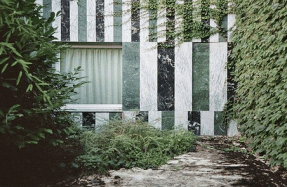The Attitudes of Architecture in a Park




The Beginning of the Forest Library
KJE Kim Jeoungeun We visited the Samcheong Forest Library, Soongin-jae and the Baebongsan Forest Library in the same day. Three projects by Lee Sojin share a common feature in that they are all located within a park. This series of works raises some questions as to how small-scale public architecture can engage with a park: for example, what attitudes can architecture adopt when approaching a site such as a park – where the natural environment is of the highest priority – and what kind of programme is required of a park that is closely connected to local daily life? Also, it’s worth mentioning here that two of these projects feature a library as part their programme, and that at a previous meeting, Lee had also noted how a library is a programme well-suited to a park. To begin this discussion, I’d like to invite Lee to give a background introduction to how you came to embark upon this series of works.
LSJ Lee Sojin My first interaction with the park began with Yun Dong-Ju Literary Museum, which was completed in 2012 as part of the Inwang Mountain Urban Natural Park. The subsequent project was the Samcheong Forest Library, which was then followed by a series of projects in various parks located in Jongno-gu, Dongdaemun-gu, Nowon-gu, Yangcheon-gu, Gwanak-gu, and Guro-gu. Although these projects, which are mostly deeply connected to local daily life, can be somewhat diverse – ranging from exhibition halls, libraries, maintenance offices, public toilets, local resting areas, gardening centres, urban agricultural complexes, and camping facilities – these projects share similarities nonetheless in that most of them are small-scale works of public architecture under 300m2 in size. For this purpose, I took a look at the floor plans of these projects, and I observed that most of them followed a pattern of different plans between upper and lower floors due to the way their spaces were created in abeyance of original geography and traffic lines, and in the way the plan angles are organised according to a given situation.
In the frame section, I was given the opportunity to introduce the Samcheong Forest Library, Soongin-jae, and the Baebongsan Forest Library—three wooden buildings that may be used as a library or as a resting place in a forest. As they gradually become an integratal part of these beautiful parks, they will continue to hold a special place in my heart. What became most important to me as I worked on these projects was the effort to create a natural space in which all visitors can be at ease. In that sense, I am really curious to hear what others have to say as we look at these three projects.
KJE I heard that an organising team had been established to build forest libraries in Seoul, after Samcheong Forest Library entered the spotlight.
“Many of Seoul’s neighborhood parks have mountainous topographical features. I see site selection as the most important factor when it comes to construction within a forest.”
YSJ Actually, the initial starting point was the environmental improvement project, Hangang Interchange (IC). What was key to that project was to avoid disturbing the environment while maintaining the symbol of Hangang. Our Geumho IC project design became the first completed IC back then, and we also witnessed its expansion soon after the mayor of Seoul decided to visit the site. With Samcheong Forest Library as its starting point, Seoul Metropolitan Government now plans to build 20 more forest libraries in the city before 2023, and it has already earmarked 36 billion KRW for that purpose. This also reveals the significance of the role of an architect. When designed well, even a small-scale space can turn into a policy statement, and therefore public architecture must always be done with care. Furthermore, since it is funded by taxpayers, public architecture requires clever planning to ensure that many people will reap the benefits. When designing projects within forests, as one reflects on a location’s appropriateness and appropriate project scale, I think
You’re reading a preview, subscribe to read more.
Start your free 30 days





